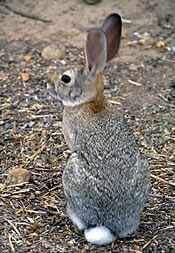Nutrition
Foxes in general are well known for having a very diverse diet, and the red fox is no exception. A common misconception is that the red fox only eats meat, this is untrue, and red foxes have been known to consume corn, apples, and acorns under the right conditions (National Geographic). The red fox will eat as much protein as it can however, finding a succulent meal from insects, rodents, and small mammals (Bassett, 1951).
The red fox primarily hunts alone and foxes are especially good
at capturing small to medium size prey (Harris, 1986). Although the
red fox mainly hunts at night, the red fox is not strictly nocturnal
(Rue, 1969). The fox normally hunts at night because this is when
their prey is the most active (Harris,
1986).

The red fox will consume a great number of insects, mainly because insects are relatively easy to catch and very numerous (Harris, 1986). The insects will offer very little energy so the fox will have to eat a great many of them to sustain their needs (Harris, 2009). Kits learning to hunt will primarily capture insects as prey while they are still young and continue capturing insects as they mature (Harris, 1986).
Small, burrowing rodents make up another large portion of a foxes diet (National Geographic). These animals are mice, voles, and pocket gophers. Although these animals require more energy to capture than insects, they will also reward the fox with much more energy (Harris, 1986). In order to capture this prey the red fox will hunt using a “mousing leap,” meaning that the fox will gt into a crouched position, raise its head and perk up its ears (Grambo, 1995). While employing this technique the fox will move in stealth like fashion using their acute sense of smell to determine the exact location of the prey (Harris, 2009). The last step in this technique is to kill the animal through a series of quick bites (Grambo, 1995).
Another technique used by the red fox in prey capture is stalking
(Rue, 1969). The red fox will use stalking to catch medium size
prey, such as rabbits and moles (Rue, 1969). The fox would use
stalking against animals that will run to avoid being caught. When
the fox first detects the prey it will crouch low to the ground and
slowly move towards the intended target (Grambo, 1995). The fox
will keep its eyes locked on the target the entire time and will
attempt to get as close as possible to the prey before detection.
Once the fox has been detected the prey will flee causin g
a chase to ensue. The fox will attempt to disable the prey by
biting it in either the legs or the haunches. The chase will end in
either a tasty meal for the fox or another day for the lucky
prey.
g
a chase to ensue. The fox will attempt to disable the prey by
biting it in either the legs or the haunches. The chase will end in
either a tasty meal for the fox or another day for the lucky
prey.
The red fox will sometimes use an adapted version of stalking to capture birds as prey (Grambo, 1995). Birds do not however, make up a large portion of the red foxes diet (Harris, 1986).
The red fox would do almost anything to capture a tasty meal, including some rather unorthodox methods. One technique is for the fox to attract prey by engaging in playful antics (National Geographic). Once the prey becomes curious and comes closer to the fox to investigate, then the fox will immediately pounce on the prey. This technique is referred to as “charming” (National Geographic). Another technique occasionally used by the red fox is to play dead. The red fox will play dead and wait to ambush the birds that come to feed off the fox’s carcass (Grambo, 1995). Both of these techniques are extremely different than the stealth technique normally applied by the red fox.
To learn more about the life cycle of the red fox, visit the reproduction page!